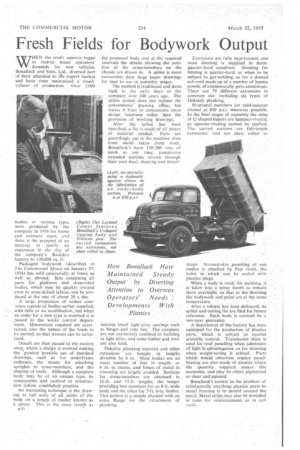Fresh Fields for Bodywork Output
Page 44

If you've noticed an error in this article please click here to report it so we can fix it.
WHEN the credit squeeze began to restrict home• operators' demands for new vehicles, Bonallack and Sons, Ltd., diverted part of their attention to tte export market and have since maintained a steady volume of production. Over 2.000
bodies ot various types were produced by the company in 1956 for home. and overseas users. and there is the prospect of an increase to justify an expansion in the size of the company's Basildon factory to 120,000 sq. ft.
Packaged bodywork (described in The Commercial Motor on January 27, 1956) has sold successfully at home as well as abroad. Kits containing all parts for platform and drop-sided bodies, which may be quickly erected even by semi-skilled labour, can be produced at the rate of about 20 a day.
A large proportion of orders corn)rises repeats of bodies earlier supplied, with little or no modification, but when an order for a new type is .received it is _passed to the works control department. Dimensions required are ascertained, also the nature of the loads to be carried, so that stresses can be calcu lated. •
Details arc then passed to the pattern shop; where a design is evolved making the greatest possible use of standard drawings, such as for underframe pedestals, the means for attaching uprights • to cross-members, and the shaping a roofs. Although a complete body may be of an unique type, its components and method of construction follow established practice.
An interesting, technique is the drawing to full scale of all joints of the body on a length of timber known as a spline. This is the same length as nI0 the proposed body and at the required intervals the details showing the position of the cross-members on the chassis are drawn in. A spline is more convenient than large paper drawings for men to use in assembly stages.
The method is traditional and dates back to the early days of the company over 100 years ago. The spline system does not replace the conventional drawing office, but leaves it freer to concentrate upon design functions rather than the provision of working drawings.
After the spline, has been inscribed, a list is made of all pieces of , material needed. Parts are accordingly cut in the machine shop from metal taken from stock. Bonallack's have 150-200 tons of stock at any time, comprising extruded sections (drawn through their own dies), sheeting and miscel lancous small light-alloy castings such as hinges and rope ties. The company are not exclusively confined to building in light alloy, and some timber and steel are also held.
Dekaloy planking material and other extrusions are bought in lengths divisible by 6 in. Most bodies are an exact number of feet in length, or 6 in. in excess, and losses of metal in trimming are largely avoided. Sections for Cross-members are obtained in 16-ft. and 15-ft. lengths, the longer providing two members for an S-ft.-wide body and the other for 7-ft. 6-in. bodies, This section is a simple channel with an extra flange for the attachment of planking. Extrusions are fully heat-treated, and most sheeting is supplied in threequarter-hard condition. Sheeting for beating is quarter-hard, or when to be subject to gas-welding, as for a domed cab roof made up of a number of beaten panels, of commercially pure aluminium. There are 79 different extrusions in common use, including, six types of Dekalciy planking. Structural members are Cold-squeeze riveted at 850 p.s.i. wherever possible. In the final stages of assembly the sides of U-shaped tippers are hammer-riveted. as squeeze-riveting cannot be applied. The curved sections are full-length extrusions, and not plate rolled to shape. Stressed-skin panelling of van bodies is attached by Pop rivets, the holes in which can be sealed with plastics plugs.
When a body is ready for painting, it is taken into a spray booth to -remain there overnight, so that in the'rhorning the bodywork and paint are at the same temperature.
After a vehicle has been delivered, its spline and cutting list are filed for future reference. Each body is covered by a two-year guarantee.
A department of the factory has been equipped for the production of plastics parts, which is subject to careful• scientific control. Translucent sheet is used for roof panelling when admission of light Is advantageous, or for skinning when weight-saving is critical. Parts which would otherwise require panelbeating are also made of plastics where the quantity required makes this economic, and may be either pigmented or clear and painted.
Bonallack's answer to the problem of satisfactorily attaching plastics parts to metal framing is to mould around the metal. Metal strips may also be mouldedin resin for reinforcement, as in cab roofs




























































































